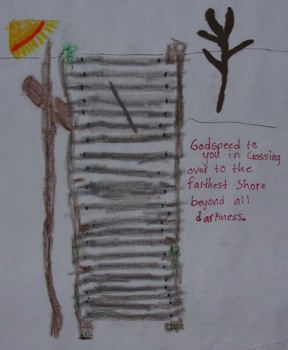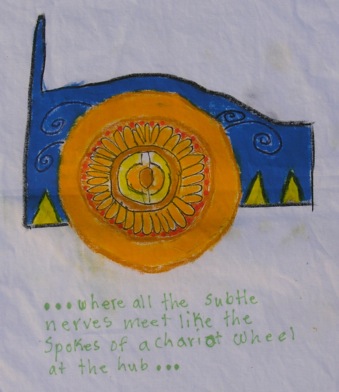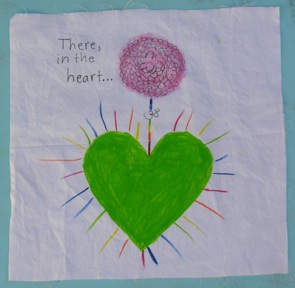My favorite part was doing the quilt and working with annapruna [Annapurna] was really fun. It gave me a new persecptive [perspective] in vadate [Vedanta]. I am better at concentraing [concentrating] now.
— zuzu
A Solo Retreat
This year’s River Retreat witnessed a graduation of our former “children” into the adult classes, and the beginning of a new series of children’s classes. Our youngest student, Zuzu, who is 8 years old, was the only one of our kids able to make the retreat.
Undaunted, we held a solo kid retreat that both teacher and student found exceptionally rewarding. Reflecting afterwards on the week’s experiences, Annapurna shared the following:
“I was not sure how a kids retreat would work with one child, but as I delved deeper into the preparation of each day’s lessons, I realized I had been gifted with a rare opportunity to connect very deeply, one on one – to share the Vedanta and the tools of spiritual life from the heart, tailored spontaneously to the needs of one very intelligent child for six whole days. It was an indelible experience and almost too deep for words. I learned a lot, and the joy I had in sharing was matched by Zuzu’s openness and sense of adventure with the teachings and practices.”
Each summer retreat has a major art or science project. In previous years it has been a telegraph and a mosaic sundial. This year it was a quilted hanging made from squares depicting what Zuzu learned from each lesson. A special thanks goes out to Manjushri who organized all the materials for the quilting.
 The Bridge Beyond all Darkness
The Bridge Beyond all Darkness
This year’s lessons were drawn from one of our SRV meditation chants:
Om – Ara iva rathanabhau samhata yatra nadyah
sa esho’ntashcharate bahudha jayamanah
omityevam dhyayatha atmanah
svasti vah paraya tamasah parastat
(Mundako Upanisad II.ii.6)
Om – There, within the heart, where all the subtle nerves meet like the spokes of a chariot wheel at the hub — there the Atman abides, unmoving yet assuming many forms. Meditate on that Self with the help of Om, and Godspeed to you in crossing over to the farthest shore beyond all darkness.
The last line in Sanskrit, “Svasti vah….,” (Godspeed to you in crossing over to the farther shore beyond all darkness) has been used for years as one of the secret “passphrases” needed to cross over the bridge spanning the seasonal stream to the children’s teaching tent. The children have to learn it in Sanskrit and English, and they take delight in teaching it to the adults who want to see their classroom. This year, the entire verse was taught by dividing it into five lessons:
Day 1 – There within the heart
Day 2 – Where all the subtle nerves meet like the spokes of chariot wheel at the hub–
Day 3 – There the Atman abides, unmoving yet assuming many forms
Day 4 – Meditate on that Self with the help of AUM
Day 5 – Godspeed to you in crossing over to the farthest shore beyond all darkness.
Each lesson included a little Sanskrit teaching, a discussion, quotes to think about, a story, a riddle, a contemplation, and then an activity. During discussions, we used a book made of clear plastic sheets and white board markers to depict subtle ideas that needed layering to understand. For instance, we talked a lot about the 3 bodies (gross, subtle and causal). The plastic sheets made it possible to depict how these are different but exist in one person. Zuzu enjoyed linking the Sanskrit words to their English counterparts and then decoding the Sanskrit line for the day. She did not need to be told to take these steps. It was completely natural for her. To give an idea of what an entire lesson consisted of, the lesson for Day Two is pasted below. It has Zuzu’s favorite riddle. Can you guess the answer?
Lesson Two
Ara iva rathanabhau samhata yatra nadyah
…where all the subtle nerves meet like the spokes of a chariot wheel at the hub
 Sanskrit:
Sanskrit:
nadis = subtle nerves
ara iva = like the spokes
samhata = are pinned
rathanabhau = (at the) hub of a chariot wheel
Discussion:
What are nerves? What do they do? What beings have nerves?
Can we see physical nerves? Subtle nerves?
What is prana?
What does it do in the physical body?
What does it do in the physical universe?
What is psychic prana?
What does it do in the subtle body?
What does it do in the subtle body of the universe?
Describe different states of mind (joy, happiness, sorrow, inspiration, etc) and how they are related to prana and nerves. Where do you feel these different emotions/states?
 “Hundred and one are the nerves of the heart; of them one has extended toward the crown of the head. Going upwards by it, man attains immortality; but others lead in departing differently.” – Yama to Nachiketas, Katho Upanisad
“Hundred and one are the nerves of the heart; of them one has extended toward the crown of the head. Going upwards by it, man attains immortality; but others lead in departing differently.” – Yama to Nachiketas, Katho Upanisad
Riddle:
If you lined up all the nerves in the human body end to end, they would reach 45 miles. That’s about the distance from Portland to Salem, or Sacramento to Stockton. If you placed all your blood vessels together they would go around the Earth 2.5 times! But if you were to put all your subtle nerves together, where would they reach?
Story:
Prana proves it is superior to the gods
The gods (senses of knowledge: hearing, seeing, etc) convened a meeting one day to discuss who was superior. They each spoke about their unique greatness and why that made them better than all the other senses. Afterwards, Prana said, “You are wrong. I am greater than all of you, and I will prove it.” Prana left the body and the senses fell down. When he returned, they began to function again. Therefore all the senses praised Prana.
Contemplation:
Sit still with eyes closed and concentrate on all the ways you experience prana in your physical and subtle bodies, and also all around you. Do you feel the wind moving? Are there sounds traveling through space so that you can hear them? Feel your breath and your heart beating. Feel the movement of your mind concentrating on each thing.
Activity:
Draw the different kinds of bodies and nerves using the plastic sheets.
Draw a picture on the quilt cloth depicting the nerves meeting at the heart, like the spokes of a wheel at the hub.
~~~~~~~~~~~~~~~
Annapurna wrote two blogs on the children and young adults classes for Advaita Academy. You can read them at:
http://www.advaitaacademy.org/blogs/Annapurna/Teaching-Children-Vedanta.ashx
